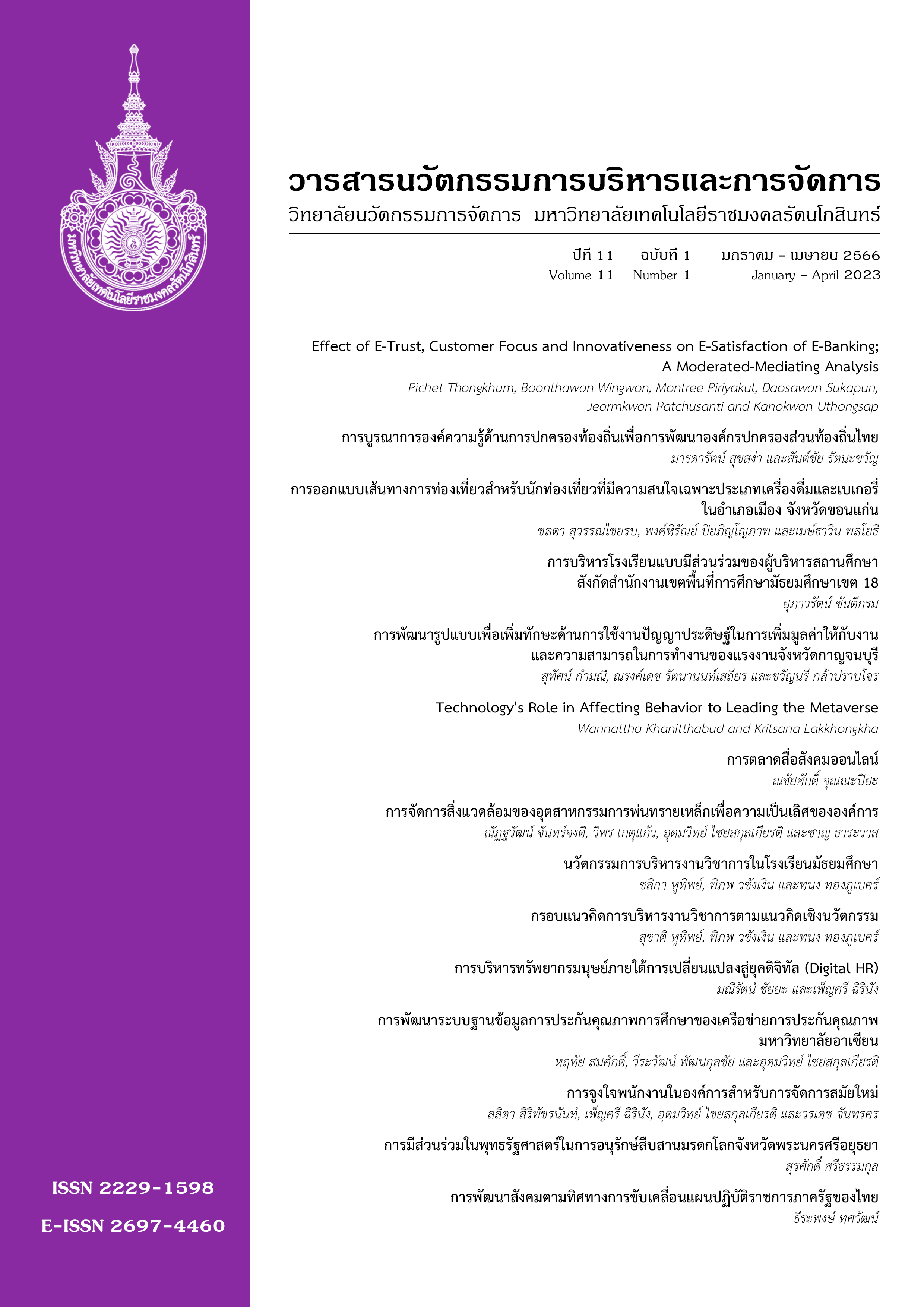การพัฒนาสังคมตามทิศทางการขับเคลื่อนแผนปฏิบัติราชการภาครัฐของไทย
Main Article Content
บทคัดย่อ
บทความนี้เป็นบทความวิชาการ มุ่งเสนอแนวคิดการพัฒนาสังคมตามทิศทางการขับเคลื่อนแผนปฏิบัติราชการภาครัฐ โดยอธิบายถึง 1) การพัฒนาศักยภาพคนและสร้างความเข้มแข็งของสถาบันครอบครัวอย่างยั่งยืน มีการขับเคลื่อนพัฒนาศักยภาพและโอกาสของคนรุ่นใหม่ สร้างความรู้ ทักษะความสามารถ และขับเคลื่อนการสร้างความเข้มแข็งของสถาบันครอบครัว 2) การสร้างโอกาสและยกระดับการคุ้มครองทางสังคมสำหรับคนทุกช่วงวัย ขับเคลื่อนงานในมิติใหม่โดยมีเป้าหมาย คือ ทุกครอบครัวเข้าถึงการคุ้มครองทางสังคม ลดความยากจน และสร้างความยั่งยืน 3) การพัฒนาทุนทางสังคม มีการสร้างกระบวนการมีส่วนร่วม เสริมเศรษฐกิจฐานรากสู่การเป็นหุ้นส่วนการพัฒนาสังคมที่ยั่งยืน ส่งเสริมการลงทุนทางสังคมในรูปแบบใหม่ ปรับกลไกการขับเคลื่อนงานเชิงพื้นที่ที่มุ่งเน้นการพัฒนาสังคมแบบองค์รวม เสริมสร้างพลเมืองที่มีส่วนร่วม พลเมืองตื่นรู้ และสังคมที่ยั่งยืน 4) การมุ่งพัฒนาองค์กรให้มีสมรรถนะและผลสัมฤทธิ์สูงเพื่อรองรับการเปลี่ยนแปลงในยุคดิจิทัล ขับคลื่อนการพัฒนาหลักสูตรสมรรถนะด้านดิจิทัลสำหรับข้าราชการและบุคลากรภาครัฐให้เข้าสู่กรอบมาตรฐานหลักสูตรในยุคดิจิทัล สรุปได้ว่าภาครัฐมีการกำหนดทิศทางการพัฒนาสังคมตามทิศทางการขับเคลื่อนแผนปฏิบัติราชการภาครัฐของไทย รับฟังความคิดเห็นของประชาชนเพื่อสร้างนโยบายทิศทางการพัฒนาสังคมตามทิศทางการขับเคลื่อนแผนปฏิบัติราชการ ภาครัฐควรเร่งรัดการดำเนินกิจกรรมโครงการต่าง ๆ ให้ครอบคลุมทุกกลุ่มเป้าหมาย และมุ่งเน้นส่งเสริมให้ทุกช่วงวัยมีศักยภาพอย่างเหมาะสม
Article Details

อนุญาตภายใต้เงื่อนไข Creative Commons Attribution-NonCommercial-NoDerivatives 4.0 International License.
ข้อความและบทความในวารสารนวัตกรรมการบริหารและการจัดการ เป็นแนวคิดของผู้เขียน ไม่ใช่ความคิดเห็นและความรับผิดชอบของคณะผู้จัดทำ บรรณาธิการ กองบรรณาธิการ วิทยาลัยนวัตกรรมการจัดการ และมหาวิทยาลัยเทคโนโลยีราชมงคลรัตนโกสินทร์
ข้อความ ข้อมูล เนื้อหา รูปภาพ ฯลฯ ที่ได้รับการีพิมพ์ในวารสารนวัตกรรมการบริหารและการจัดการ ถือเป็นลิขสิทธิ์ของวารสารนวัตกรรมการบริหารและการจัดการ หากบุคคลใดหรือหน่วยงานใดต้องการนำทั้งหมดหรือส่วนหนึ่งส่วนใดไปเผยแพร่ต่อหรือกระทำการใดๆ จะต้องได้รับอนุญาติเป็นลายลักษณ์อักษรจากวารสารนวัตกรรมการบริหารและการจัดการก่อนเท่านั้น
เอกสารอ้างอิง
กระทรวงการพัฒนาสังคมและความมั่นคงของมนุษย์. (2566ก). แผนปฏิบัติราชการระยะ 5 ปี (พ.ศ. 2566-2570) ของกระทรวงการพัฒนาสังคม และความมั่นคงของมนุษย์. กรุงเทพฯ: กระทรวงการพัฒนาสังคมและความมั่นคงของมนุษย์.
กระทรวงการพัฒนาสังคมและความมั่นคงของมนุษย์. (2566ข). แนวทางการส่งเสริมศักยภาพผู้ด้อยโอกาส และการเข้าถึงสวัสดิการของภาครัฐ. กรุงเทพฯ: กระทรวงการพัฒนาสังคมและความมั่นคงของมนุษย์.
กระทรวงการพัฒนาสังคมและความมั่นคงของมนุษย์. (2566ค). แนวทางการเสริมสร้างความเข้มแข็งของสถาบันครอบครัว. วารสารสตรีและครอบครัวฉบับพิเศษ, 3(13), 14.
กฤษฎา ธีระโกศลพงศ์. (2564). การคุ้มครองทางสังคม : มาตรการของรัฐบาลไทยในการสนองตอบวิกฤติการณ์โควิด-19. วารสารธรรมศาสตร์, 40(1), 10-58.
คณะกรรมการข้าราชการพลเรือน. (2566). Digital Government Skill Curriculum Management (DGSC) ระบบพิจารณาขึ้นทะเบียนหลักสูตรพัฒนาสมรรถนะด้านดิจิทัลสำหรับข้าราชการและบุคลาการภาครัฐ. สืบค้น 10 กุมภาพันธ์ 2566, จาก https://dgsc.dga.or.th/home/about_us
ชัยทวี เสนะวงศ์. (2563). คุณลักษณะของ “Digital Organization”. สืบค้น 10 กุมภาพันธ์ 2566, จาก https://www.khonatwork.com/
ณดา จันทร์สม. (2566). ทุนทางสังคมกับการพัฒนาชุมชนอย่างยั่งยืน. เรียกใช้เมื่อ 10 กุมภาพันธ์ 2566, จาก https://econ.nida.ac.th/
ณัฏฐวุฒิ ทรัพย์อุปถัมภ์. (2560). ทฤษฎีและหลักการพัฒนาชุมชน. จันทบุรี: มหาวิทยาลัยราชภัฏรำไพพรรณี.
ดิเรก ฤกษ์หร่าย. (2552). ทฤษฎีและแนวทางการพัฒนาสังคม. นนทบุรี: มหาวิทยาลัยสุโขทัยธรรมาธิราช.
ตรีนุช เทียนทอง. (2565). แผนปฏิบัติการดิจิทัลเพื่อการศึกษา กระทรวงศึกษาธิการ พ.ศ. 2563-2565. กรุงเทพฯ: กระทรวงศึกษาธิการ.
นุชจรี วงษ์สันต์. (2559). ทิศทางและการพัฒนาประเทศตามนโยบายของรัฐบาล และแผนพัฒนาเศรษฐกิจและสังคมแห่งชาติ ฉบับที่ 12. ชลบุรี: วิทยาลัยมหาดไทย.
พระครูใบฎีกาวิชาญ วิสุทโธ. (2565). การขับเคลื่อนตลาดนัดชุมชนสู่การพัฒนาเศรษฐกิจฐานราก การขับเคลื่อนตลาดนัดชุมชนสู่การพัฒนาเศรษฐกิจฐานราก. วารสารมหาจุฬาคชสาร, 13(2), 1-14
พระมหากฤษฎา กิตฺติโสภโณ. (2564). การพัฒนาศักยภาพและโอกาสของคนรุ่นใหม่ในการออกแบบอนาคต ชุมชนเชิงสร้างสรรค์. วารสาร มจร สังคมศาสตร์ปริทรรศน์, 10(1), 1-13.
พริมธพัทต์ จริยานพิวาทย์. (2566). พม. ประชุมติดตามการขับเคลื่อนโครงการสำคัญ (Flagship Projects) ประจำปี 2566. สืบค้น 10 กุมภาพันธ์ 2566, จาก https://webcache.googleusercontent.com/
พัฒนพงศ์ สุกิจปาณีนิจ. (2566). ทุนทางสังคมกับการพัฒนาประเทศ. สืบค้น 10 กุมภาพันธ์ 2566, จาก https://kukr.lib.ku.ac.th/
ฟ้าลั่น กระสังข์. (2562). ทุนชุมชนกับกระบวนการมีส่วนร่วมสู่การเป็นชุมชนพึ่งตนเอง : ศึกษาเปรียบเทียบระหว่างชุมชนรางหวายและหนองสาหร่ายอำเภอพนมทวน จังหวัดกาญจนบุรี, วารสารรังสิตบัณฑิตศึกษาในกลุ่มธุรกิจและสังคมศาสตร์, 5(2), 61-73.
สำนักงานกองทุนสนับสนุนการสร้างเสริมสุขภาพ. (2566). ทิศทางการขับเคลื่อนงานด้านผู้สูงอายุภายใต้ความท้าทายใหม่สถานการณ์โควิด-19. สืบค้น 10 กุมภาพันธ์ 2566, จาก https://thaitgri.org/?p=39128
สำนักงานคณะกรรมการพัฒนาการเศรษฐกิจและสังคมแห่งชาติ (สศช). (2560). ศักยภาพคนไทยเพื่ออนาคตประเทศไทย. กรุงเทพฯ: สำนักงานคณะกรรมการพัฒนาการเศรษฐกิจและสังคมแห่งชาติ (สศช).
สำนักงานศาลาว่าการกรุงเทพมหานคร. (2566). การพัฒนาสมรรถนะในการบริหารจัดการทรัพยากรบุคคล. กรุงเทพฯ: สำนักงานศาลาว่าการกรุงเทพมหานคร.
สำนักงานสภาพัฒนาการเศรษฐกิจและสังคมแห่งชาติ. (2566). การพัฒนาศักยภาพคนตลอดช่วงชีวิต. กรุงเทพฯ: สำนักงานสภาพัฒนาการเศรษฐกิจและสังคมแห่งชาติ.
อนุกูล ปีดแก้ว. (2566). ปลัด พม. ย้ำขับเคลื่อนงานมิติใหม่ เน้นทุกครอบครัวเข้าถึงการคุ้มครองทางสังคม ลดความยากจน สร้างความยั่งยืน. สืบค้น 10 กุมภาพันธ์ 2566, จาก https://www.thaigov.go.th/
Cernea. M. M. (1991). Putting People First. London: Oxford University Press.
Conyers, D. & Hills, P. (1984). An Introductory to Development Planning in Third World. NY: John Wiley & Sons.
Waterstone, Michael. (1969). Political Participation for Peoplewith Disabilities. NY: Mc Graw-Hill.


